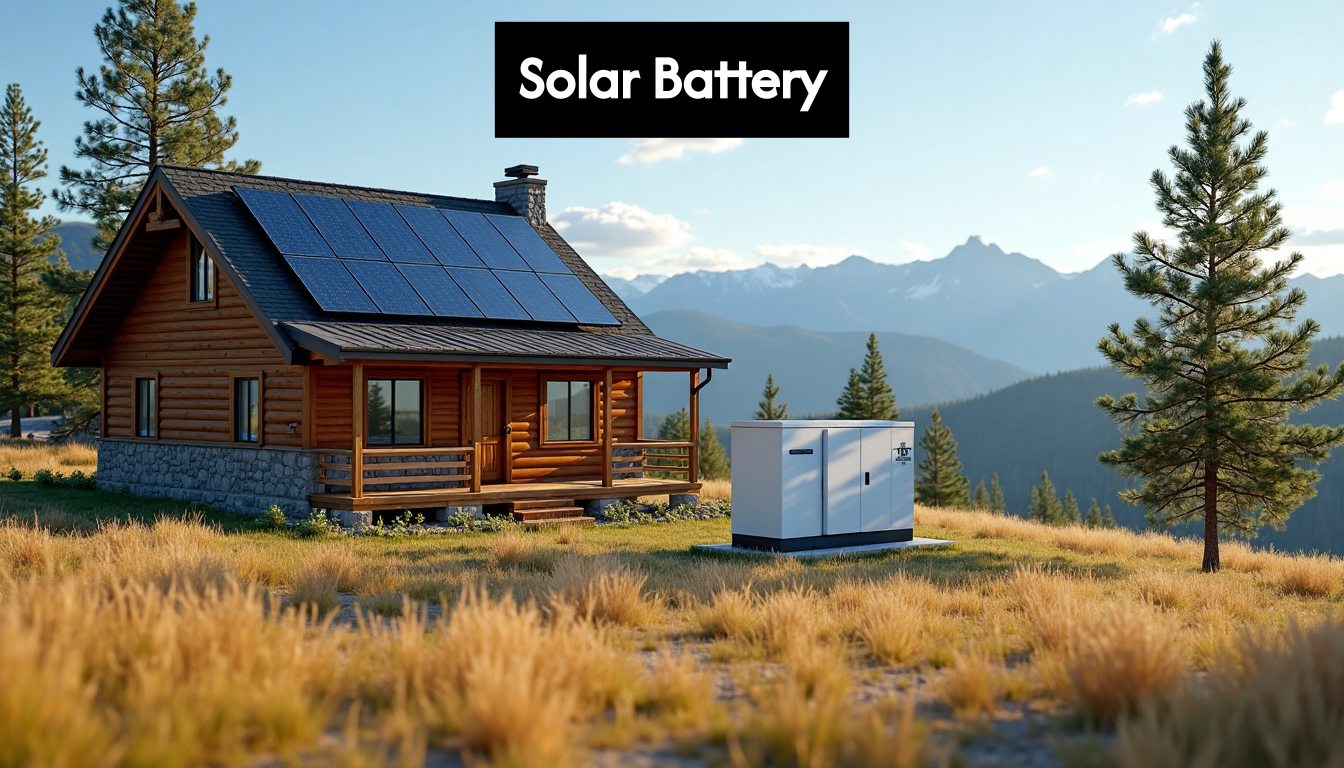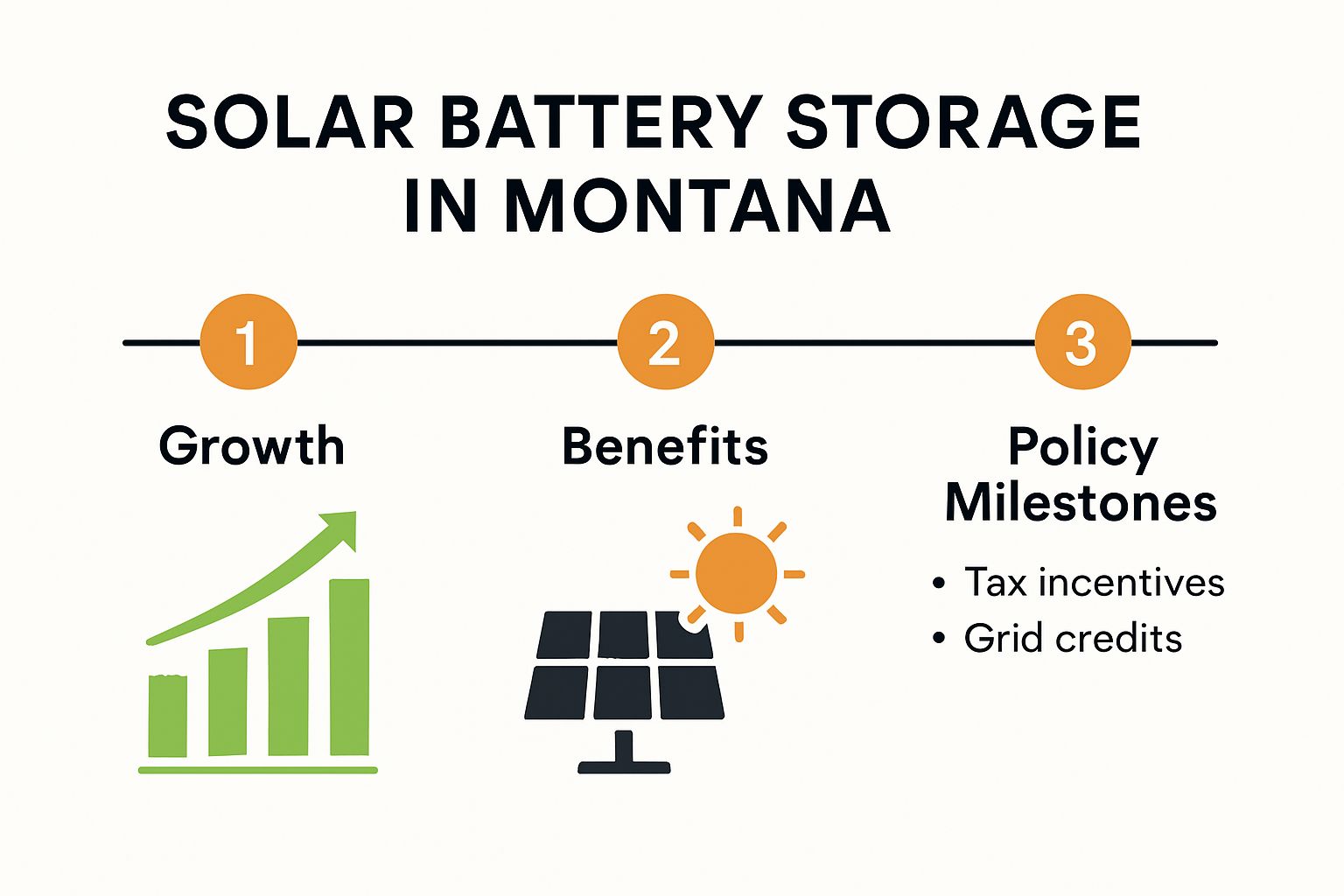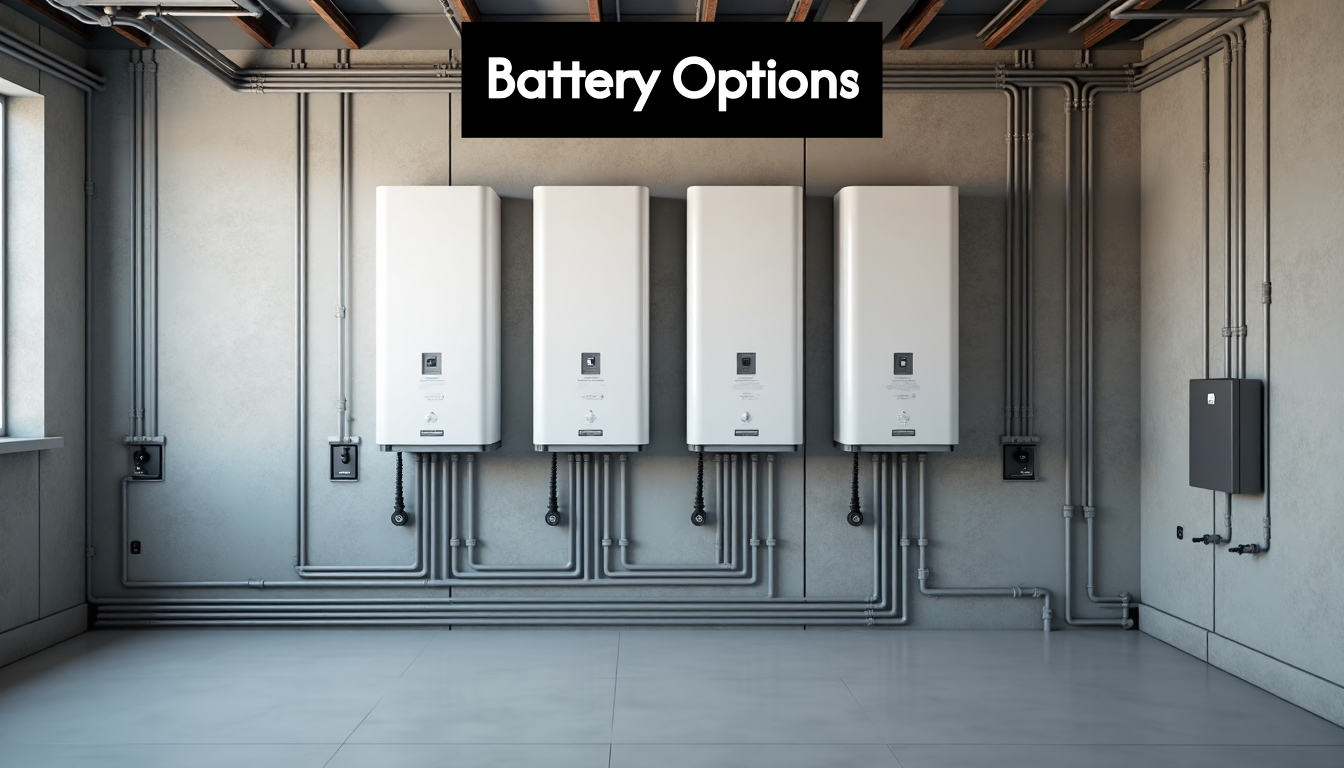Solar Battery Storage in Montana: Smart Solutions for 2025
Contact Us

Solar battery storage is gaining serious momentum in Montana as residents tackle rising electricity costs and unpredictable weather. The numbers say it all. Federal incentives cover up to 30 percent of battery system costs and Montana offers a 100 percent property tax exemption for renewables. Surprised? That only scratches the surface. The real twist is that new state policies now let homeowners earn credits for stored power sent back to the grid, turning solar battery storage into a legit income opportunity. Here’s how Montana is flipping the script on energy self-reliance in 2025.
Table of Contents
- Why Solar Battery Storage Matters In Montana
- Economic Advantages Of Energy Storage
- Climate Resilience And Energy Independence
- Environmental And Community Impact
- Best Solar Battery Options For Montana Properties
- Performance And Efficiency Considerations
- Scalability And Flexibility
- Climate-Specific Battery Performance
- Cost, Savings, And Incentives For Solar Battery Storage
- Initial Investment And System Costs
- Long-Term Economic Benefits
- Financial Planning And Incentive Strategies
- Getting Started: Installation And Local Support
- Selecting The Right Installation Partner
- Comprehensive Installation Assessment
- Navigating Permits And Technical Requirements
| Takeaway | Explanation |
|---|---|
| Economic Benefits of Solar Battery Storage | Homeowners can reduce reliance on grid electricity and earn credits through net metering in Montana, making battery storage an attractive investment due to rising electricity rates. |
| Importance of Performance and Scalability | Selecting batteries with high efficiency, temperature tolerance, and scalability is crucial for Montana's diverse energy needs and environmental conditions. |
| Financial Incentives Available | Montana residents can benefit from a 30% federal tax credit, a 100% property tax exemption, and various financing options to maximize the economic advantages of solar battery storage. |
| Local Installation and Support | Partnering with certified local installation professionals is essential for successful implementation, ensuring compliance with regulations and tailored solutions based on individual property assessments. |
| Community and Environmental Impact | Transitioning to solar battery storage supports cleaner energy models, reduces carbon emissions, and enhances energy resilience, particularly for rural communities in Montana. |
Why Solar Battery Storage Matters in Montana
Solar battery storage represents a transformative energy solution for Montana residents, offering unprecedented reliability and economic advantages in a state known for its diverse and sometimes challenging climate conditions. Understanding the critical role of solar battery storage requires examining its multifaceted benefits across residential, commercial, and community resilience frameworks.

Economic Advantages of Energy Storage
Montana homeowners face escalating electricity costs and increasing grid uncertainty. Solar battery storage provides a strategic approach to managing these challenges. By capturing excess solar energy during peak production hours, residents can significantly reduce their reliance on traditional grid electricity. According to Solar Energy Industries Association, the state's electricity rates are projected to increase, making behind-the-meter battery storage an increasingly attractive investment.
The financial benefits extend beyond immediate energy savings. Montana's evolving renewable energy policies, such as Order 7621b, now allow energy storage systems to be eligible for net metering. This regulatory change means homeowners can potentially earn credits for excess energy stored and redistributed back to the grid, creating an additional revenue stream.
Climate Resilience and Energy Independence
Montana's geographic diversity presents unique energy challenges. From remote rural areas to regions experiencing extreme weather variations, solar battery storage offers critical backup power solutions. During winter storms or unexpected grid disruptions, battery systems provide continuous electricity, ensuring homes and businesses remain operational.
The state's ambitious energy storage goals further underscore this potential. Rocky Mountain Power aims to deploy 5,546 MW of storage capacity by 2040, signaling a significant commitment to renewable energy infrastructure. This strategic vision highlights battery storage not just as a technological innovation, but as a fundamental component of Montana's future energy ecosystem.Environmental and Community Impact
Beyond individual benefits, solar battery storage contributes to broader environmental sustainability. By reducing dependence on fossil fuel-generated electricity, these systems help decrease carbon emissions and support Montana's transition toward cleaner energy models. Rural communities, which often face higher energy costs and less reliable grid access, stand to gain substantially from distributed energy storage technologies.
Moreover, the first standalone battery storage project in Montana, breaking ground in 2024 with a 75 MW capacity, represents a pivotal moment in the state's renewable energy journey. This milestone demonstrates growing confidence in battery storage technologies and their potential to revolutionize how Montanans generate, store, and consume electricity.
As energy dynamics continue evolving, solar battery storage emerges not just as an option, but as a strategic necessity for Montana residents seeking economic efficiency, climate resilience, and environmental responsibility.
Best Solar Battery Options for Montana Properties
Choosing the right solar battery storage system for Montana properties requires careful consideration of performance, durability, and local climate challenges. The state's unique environmental conditions demand battery solutions that can withstand extreme temperatures and provide reliable energy backup.
Performance and Efficiency Considerations
Montana homeowners need solar battery systems that deliver exceptional efficiency and consistent performance. The SolaX Power T-BAT H 20 emerges as a top contender, offering an impressive 18 kWh single-module capacity and 95% roundtrip efficiency. This battery stands out for its robust design, capable of handling Montana's temperature fluctuations while providing substantial energy storage.
LG Chem batteries represent another premier option for Montana properties. Recommended by top installers, these batteries provide reliable performance across residential applications. Their proven track record in challenging climate conditions makes them particularly attractive for homeowners seeking dependable energy storage solutions.

Scalability and Flexibility
Rural and urban Montana properties have diverse energy needs, making scalability a crucial factor in battery selection. The PointGuard Energy BatteryPack-8.0 offers exceptional flexibility, allowing users to stack multiple 7.8 kWh modules up to a total of 390 kWh. This modular approach enables homeowners to customize their energy storage system precisely to their consumption patterns and future expansion requirements.
Scalability becomes especially important for properties with variable energy demands or those planning future solar expansions. The ability to incrementally add battery capacity ensures that homeowners can adapt their energy storage solutions as their needs evolve.
Climate-Specific Battery Performance
Montana's extreme weather conditions demand solar batteries with superior temperature tolerance. Ideal battery systems must perform efficiently in both frigid winter temperatures and occasional summer heat waves. Advanced battery technologies now incorporate thermal management systems that protect internal components and maintain optimal performance across challenging environmental conditions.
When evaluating battery options, Montana residents should consider several key performance metrics:
- Temperature Range: Batteries capable of operating between -4°F and 140°F
- Warranty Coverage: Minimum 10-year performance guarantees
- Roundtrip Efficiency: Preferably above 90% to maximize energy preservation
Homeowners should also consult local solar installation experts who understand Montana's specific energy infrastructure and can provide tailored recommendations based on individual property characteristics.
Ultimately, the best solar battery solution balances performance, durability, scalability, and cost-effectiveness. By carefully evaluating these factors, Montana property owners can select battery storage systems that provide reliable, efficient energy backup while supporting long-term sustainability goals.
Cost, Savings, and Incentives for Solar Battery Storage
Navigating the financial landscape of solar battery storage in Montana requires a comprehensive understanding of initial investments, long-term savings, and available incentive programs. Homeowners and businesses can strategically approach these investments by carefully evaluating the comprehensive economic benefits.
Initial Investment and System Costs
Montana residents considering solar battery storage face initial system costs ranging between $10,000 and $20,000, depending on capacity and specific technological requirements. According to Montana Renewables, these investments can be significantly offset through strategic financial planning and robust incentive programs.
The Federal Investment Tax Credit (ITC) offers a substantial 30% tax credit for standalone battery storage systems, dramatically reducing upfront expenses. This federal incentive applies to both battery systems installed independently and those paired with renewable energy infrastructure, providing financial flexibility for Montana property owners.
Long-Term Economic Benefits
Beyond initial tax credits, Montana residents can leverage additional financial advantages. The state provides a remarkable 100% property tax exemption for renewable energy systems, including solar battery storage. Solar Reviews confirms this exemption allows homeowners to add up to $20,000 in renewable energy system value without increasing property tax assessments for a decade.
Economic benefits extend beyond direct incentives. Solar battery storage enables energy arbitrage, allowing homeowners to store electricity during low-cost periods and utilize it during peak demand times. This strategy can result in significant annual electricity cost reductions, potentially saving hundreds to thousands of dollars depending on individual energy consumption patterns.
Financial Planning and Incentive Strategies
Successful solar battery storage investments require strategic financial planning. Homeowners should consider multiple financing options, including:
- Cash Purchase: Immediate ownership with maximum long-term savings
- Solar Loans: Spread investment across manageable monthly payments
- Leasing Programs: Minimal upfront costs with potential performance guarantees
- Power Purchase Agreements: Transfer system ownership while securing predictable electricity rates
Additionally, Montana utility providers may offer unique rebate programs or performance-based incentives for energy storage adoption. Consulting local solar installation experts can help identify region-specific financial opportunities that maximize return on investment.
While initial costs might seem substantial, the combination of federal tax credits, state-level property tax exemptions, and long-term energy savings make solar battery storage an increasingly attractive financial proposition for Montana residents. By understanding and leveraging available incentives, homeowners can transform solar battery storage from a significant expense into a strategic financial investment supporting both economic and environmental objectives.
Getting Started: Installation and Local Support
Embarking on a solar battery storage journey in Montana requires strategic planning, local expertise, and a comprehensive understanding of installation processes. Homeowners and businesses can navigate this transition effectively by leveraging regional resources and professional guidance.
Selecting the Right Installation Partner
Choosing a qualified solar battery storage installer is crucial for successful implementation. The Montana Renewable Energy Association provides an interactive installer directory, enabling residents to connect with certified professionals experienced in Montana's unique energy landscape. When evaluating potential installation partners, consider key criteria such as local experience, certifications, and proven track records with similar projects.
Typical installation costs for home battery systems range from $10,000 to $20,000, with variations based on system complexity and specific property requirements. Solar Reviews notes that a Tesla Powerwall installation, for example, costs approximately $15,000, with potential federal tax credits reducing the net investment significantly.
Comprehensive Installation Assessment
A thorough site assessment forms the foundation of successful solar battery storage implementation. Professional installers will evaluate several critical factors:
- Electrical System Compatibility: Assessing current infrastructure and potential upgrade requirements
- Energy Consumption Patterns: Analyzing historical usage to design optimal storage solutions
- Structural Considerations: Determining ideal battery placement and system integration
Montana's diverse geographic conditions demand customized approaches. Rural properties might require different installation strategies compared to urban settings, making professional expertise essential in designing site-specific solutions.
Navigating Permits and Technical Requirements
Installation of solar battery storage systems involves multiple regulatory and technical steps. Montana residents must obtain necessary permits, ensure compliance with local building codes, and coordinate with utility providers for grid interconnection. Professional installers typically manage these complex processes, helping homeowners avoid potential bureaucratic challenges.
Key technical considerations include:
- Electrical panel upgrades
- Proper grounding and safety installations
- Compliance with national and state electrical standards
- Utility interconnection agreements
Homeowners should anticipate a comprehensive installation process typically spanning 2-4 weeks, depending on system complexity and local regulatory requirements. Open communication with installation professionals helps set realistic expectations and ensures smooth project execution.
By partnering with experienced local installers, conducting thorough property assessments, and understanding technical requirements, Montana residents can successfully integrate solar battery storage systems that provide reliable, efficient energy solutions tailored to their specific needs.
Frequently Asked Questions
What are the economic benefits of solar battery storage in Montana?
Solar battery storage helps Montana homeowners reduce their reliance on grid electricity, earn credits through net metering, and potentially save money as electricity rates rise.
How do solar batteries perform in Montana's climate?
Solar batteries designed for Montana can withstand extreme temperatures and provide reliable energy backups, ensuring performance even during frigid winters and summer heat waves.
What incentives are available for solar battery storage in Montana?
Montana residents can benefit from a 30% federal tax credit, a 100% property tax exemption for renewable energy systems, and various financing options to offset installation costs.
How can I get started with solar battery storage in Montana?
To begin, select a qualified local installation partner, conduct a comprehensive site assessment, and navigate the necessary permits and technical requirements for installation.
Take Control of Your Montana Energy Future – With Proven Local Experts
Struggling with unpredictable electricity bills or worried about how Montana’s extreme weather might impact your power supply? You are not alone. As you read in this guide, rising utility costs and the need for reliable backup power are top concerns for homeowners in our state. Modern solar battery storage can deliver real savings, help you earn credits through net metering, and keep your lights on during outages – but only if your system is tailored to Montana’s unique climate and incentives.
Let Ellingson Roofing LLC make the process easy. We are trusted by hundreds of Montanans to install dependable battery storage that maximizes efficiency and financial incentives. Visit Ellingson Roofing LLC's main site to explore your options, learn how much you could save, and request your free local assessment today. Don’t wait for another rate hike or power interruption – secure your energy independence now.





